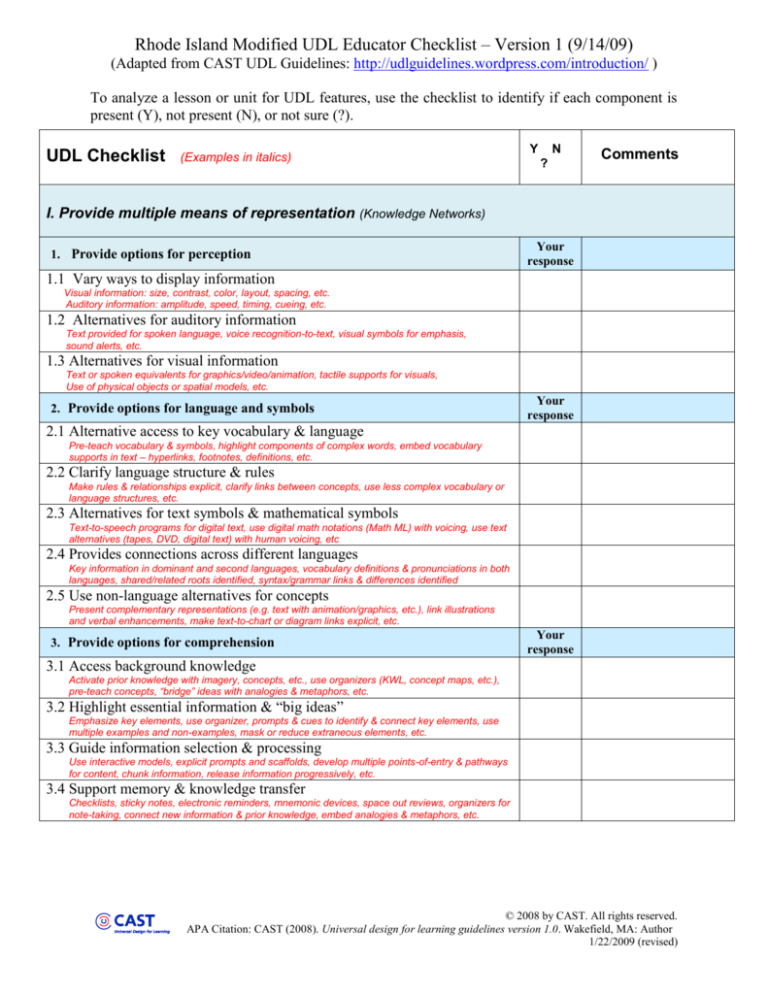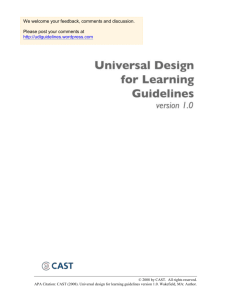
Rhode Island Modified UDL Educator Checklist – Version 1 (9/14/09)
(Adapted from CAST UDL Guidelines: http://udlguidelines.wordpress.com/introduction/ )
To analyze a lesson or unit for UDL features, use the checklist to identify if each component is
present (Y), not present (N), or not sure (?).
UDL Checklist
(Examples in italics)
Y
N
?
Comments
I. Provide multiple means of representation (Knowledge Networks)
1. Provide options for perception
Your
response
1.1 Vary ways to display information
Visual information: size, contrast, color, layout, spacing, etc.
Auditory information: amplitude, speed, timing, cueing, etc.
1.2 Alternatives for auditory information
Text provided for spoken language, voice recognition-to-text, visual symbols for emphasis,
sound alerts, etc.
1.3 Alternatives for visual information
Text or spoken equivalents for graphics/video/animation, tactile supports for visuals,
Use of physical objects or spatial models, etc.
2. Provide options for language and symbols
Your
response
2.1 Alternative access to key vocabulary & language
Pre-teach vocabulary & symbols, highlight components of complex words, embed vocabulary
supports in text – hyperlinks, footnotes, definitions, etc.
2.2 Clarify language structure & rules
Make rules & relationships explicit, clarify links between concepts, use less complex vocabulary or
language structures, etc.
2.3 Alternatives for text symbols & mathematical symbols
Text-to-speech programs for digital text, use digital math notations (Math ML) with voicing, use text
alternatives (tapes, DVD, digital text) with human voicing, etc
2.4 Provides connections across different languages
Key information in dominant and second languages, vocabulary definitions & pronunciations in both
languages, shared/related roots identified, syntax/grammar links & differences identified
2.5 Use non-language alternatives for concepts
Present complementary representations (e.g. text with animation/graphics, etc.), link illustrations
and verbal enhancements, make text-to-chart or diagram links explicit, etc.
3. Provide options for comprehension
Your
response
3.1 Access background knowledge
Activate prior knowledge with imagery, concepts, etc., use organizers (KWL, concept maps, etc.),
pre-teach concepts, “bridge” ideas with analogies & metaphors, etc.
3.2 Highlight essential information & “big ideas”
Emphasize key elements, use organizer, prompts & cues to identify & connect key elements, use
multiple examples and non-examples, mask or reduce extraneous elements, etc.
3.3 Guide information selection & processing
Use interactive models, explicit prompts and scaffolds, develop multiple points-of-entry & pathways
for content, chunk information, release information progressively, etc.
3.4 Support memory & knowledge transfer
Checklists, sticky notes, electronic reminders, mnemonic devices, space out reviews, organizers for
note-taking, connect new information & prior knowledge, embed analogies & metaphors, etc.
© 2008 by CAST. All rights reserved.
APA Citation: CAST (2008). Universal design for learning guidelines version 1.0. Wakefield, MA: Author
1/22/2009 (revised)
Rhode Island Modified UDL Educator Checklist – Version 1 (9/14/09)
(Adapted from CAST UDL Guidelines: http://udlguidelines.wordpress.com/introduction/ )
To analyze a lesson or unit for UDL features, use the checklist to identify if each component is
present (Y), not present (N), or not sure (?).
II. Provide multiple means for engagement (Affective Networks)
4. Provide options for recruiting interest
Your
response
4.1 Support individual choice & autonomy
Challenge levels, types of recognition used,vary content or context for learning, choice of information
tools, design of products, timing & sequence of tasks, etc.
4.2 Make learning personally relevant & valuable
Activities personalized to students’ lives, socially relevant, age & ability appropriate, culturally & racially
appropriate, active participation, authentic & purposeful outcomes, use of self-reflection, etc.
4.3 Reduce distractions and perceived threats
Vary novelty & risk-taking in activities & transitions (predictability, scheduling, routines, novel events,
etc.), vary sensory stimulation levels (background noise, # of items, etc.), vary pace & length of work
sessions, vary social demands required for activities, etc.
5. Provide options for sustaining effort and persistence
Your
response
5.1 Strengthen connection to goals and objectives
Develop explicit goals, restate goals for clarity, clearly display goals, develop sort-term objectives for
long-term goals, use prompts to visualize & clarify outcomes, etc.
5.2 Vary levels of challenge & support
Vary difficulty in core activities, use tools & scaffolds to provide alternatives, use collaboration, vary
ranges for acceptable work, emphasize process, effort & improvement, etc.
5.3 Support collaboration & communication with peers
Cooperative learning groups, clarify roles & responsibilities, positive behavioral supports, differentiated
supports, peer tutoring & support systems, connect to virtual communities, etc.
5.4 Focus feedback on effort, practice, and mastery
Encourage perseverance, self-awareness & self-efficacy, emphasize effort & improvement, give
frequent, on-going, & substantive feedback, model evaluation strategies, etc.
6. Provide options for self-regulation
Your
response
6.1 Support and guide personal goal-setting
Model goal-setting process, coach or mentor students in goal-setting, use prompts, rubrics, checklists,
etc. to support self-regulatory goals, on-task behaviors, and self-reinforcements, etc.
6.2 Develop individualized coping skills
Use differentiated models & feedback to develop skills e.g managing frustration, seeking emotional
support, and developing internal controls, etc.
6.3 Support self-monitoring and self-assessment
Use tools & models to collect & determine own behaviors (e.g. charts, recording devices, peers, etc.),
build student self- awareness (and reduce scaffolds) over time, etc.
III. Provide multiple means for action & expression (Strategic Networks)
7. Provide options for physical actions
Your
response
7.1 Varied & alternative physical responses
Alternatives in rate, timing, amplitude, range-of-motion, materials, manipulatives, & technologies, allow
response alternatives from standard means (e.g. computer response vs paper & pencil), etc.
7.2 Varied ways to interact with materials
Use multiple means of navigating materials (e.g. by hand, by voice, by switch, by keyboard, etc.)
7.3 Use assistive technologies for access to learning
Determine appropriate technologies (physical, sensory, cognitive, communication) needed to access
instruction, integrate training to support & enhance learning and goal achievement, etc.
© 2008 by CAST. All rights reserved.
APA Citation: CAST (2008). Universal design for learning guidelines version 1.0. Wakefield, MA: Author
1/22/2009 (revised)
Rhode Island Modified UDL Educator Checklist – Version 1 (9/14/09)
(Adapted from CAST UDL Guidelines: http://udlguidelines.wordpress.com/introduction/ )
To analyze a lesson or unit for UDL features, use the checklist to identify if each component is
present (Y), not present (N), or not sure (?).
8. Provide options for expressive skills and fluency
Your
response
8.1 Vary choices for expression of knowledge
Choices may include text, speech, illustration, physical models, film, video, pictures, music, art, etc.
8.2 Vary tools for composition & problem solving
Choices may include spell checks, grammar checks, word prediction, speech-to-text software,
dictation, recording, sentence starters, story webs, concept webs, outlining tools, calculators,
graphing calculators, software for problem solving skills, Computer-Aided Design (CAD), etc.
8.3 Vary ways to support practice and performance
Differentiated approaches, strategies, skills to achieve same outcomes, use diverse mentors to guide
differentiation processes, gradual release of supports to increase independence, etc.
9. Provide options for executive functions
Your
response
9.1 Guide & support effective goal setting
Use a variety of tools ( e.g. prompts, scaffolds, models, guides, checklists) to support process of
individualized and appropriate goal-setting, etc.
9.2 Support goal-related planning and strategy development
Use “stop & think” prompts, use checklists and templates to prioritize & sequence, model “thinkaloud” process, guide transition from long-term goals to short-term objectives, etc.
9.3 Use tools to manage information & resources
Keep information organized and accessible with graphic organizers, templates, embedded prompts,
checklists, note-taking guides, software tools, etc.
9.4 Enhance capacity for formative progress self-monitoring
Develop self-monitoring through guided questions, frequent representations of progress, selfreflection templates, differentiated self-assessment strategies, etc.
IV. Use multiple means of assessment of student understanding (All Networks)
10. Assessment for outcome determination (student understanding)
Your
response
10.1 Options for methods
Discrete vs elaborative response (ie multiple choice vs essay), varied time allowance, individualized
vs group or peer-supported, location varies w/in the curriculum, embedding assessment
opportunities, etc.
10.2 Options for formats
Visual information: photographs, pictures, picture-symbols, written, computer text, computer text-tospeech, video, kinesthetic supports (w low-tech), etc.
Auditory information: Oral, technology-supported (taped, computer speech-to-text, voiced word
processing, kinesthetic supports (w low-tech), etc.
10.3 Options for scope/range/level
Choice in number of items, type of items. Choice in focus. Deconstructs grade-level expectations.
Connects across grade levels. Tiered assessments - from “big idea”(all learners) to complex details
(some learners), Multiple levels of understanding- concrete through synthesis, etc.
10.4 Options for product & outcome
Consider formative vs summative assessment. Consider authentic assessments with “real-world”
products. Include differentiated products (e.g. plays, video productions, essays, point-of-view
“rafts”, “tic-tac-toes”, debates, artistic productions, student-driven assessments, etc.)
10.5 Options for feedback
Teacher: acknowledgement, probing, challenging questions, positive feedback, detained response,
real-time vs delayed, etc.
Student: journals, writing, prompts, reflection, peer feedback, self-evaluation, self awareness, etc.
Notes:
© 2008 by CAST. All rights reserved.
APA Citation: CAST (2008). Universal design for learning guidelines version 1.0. Wakefield, MA: Author
1/22/2009 (revised)




